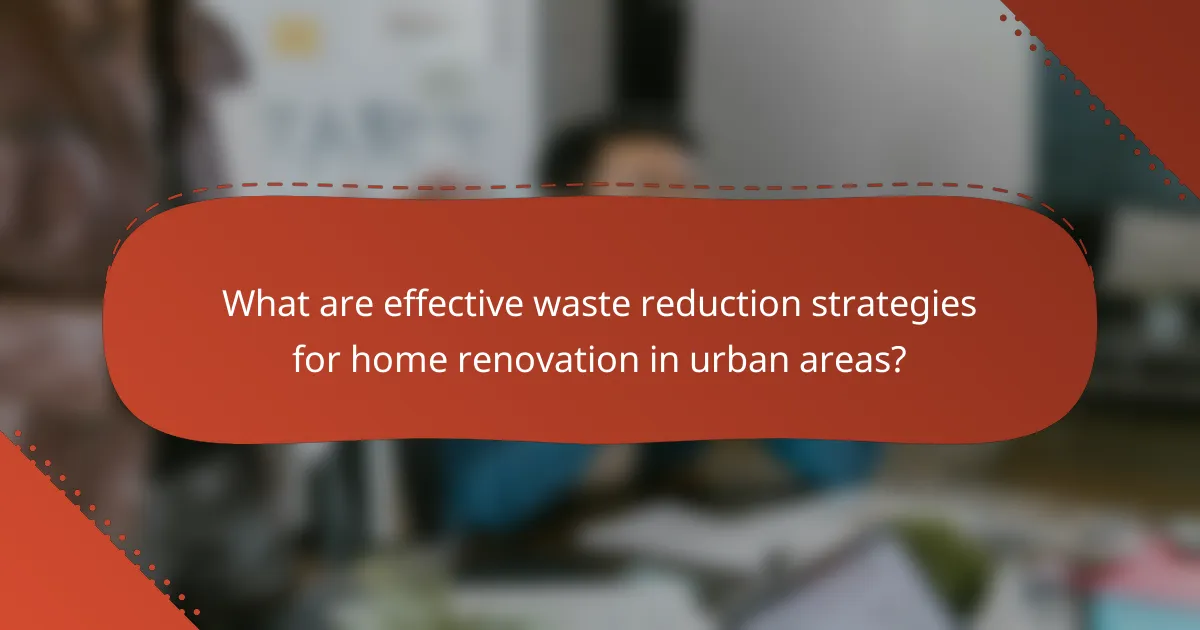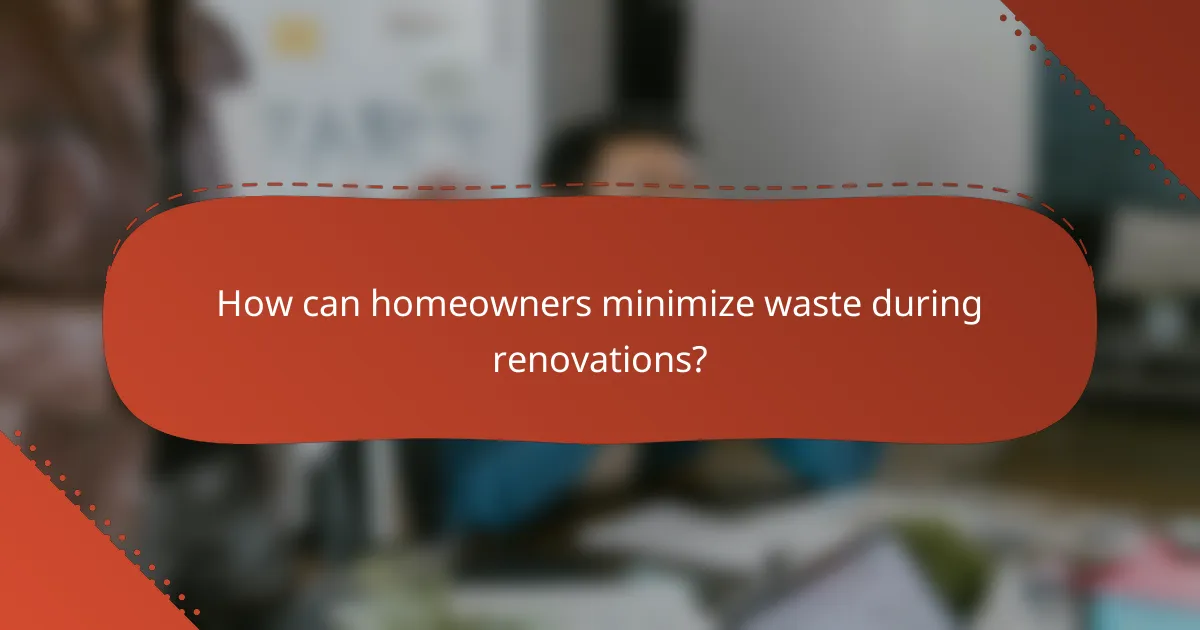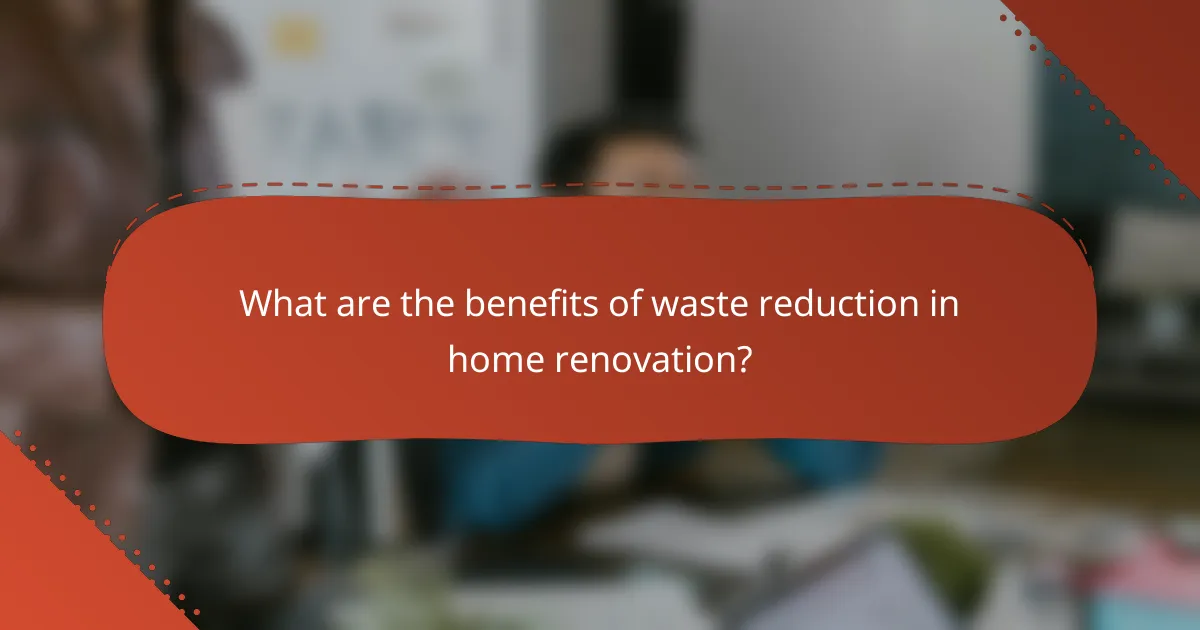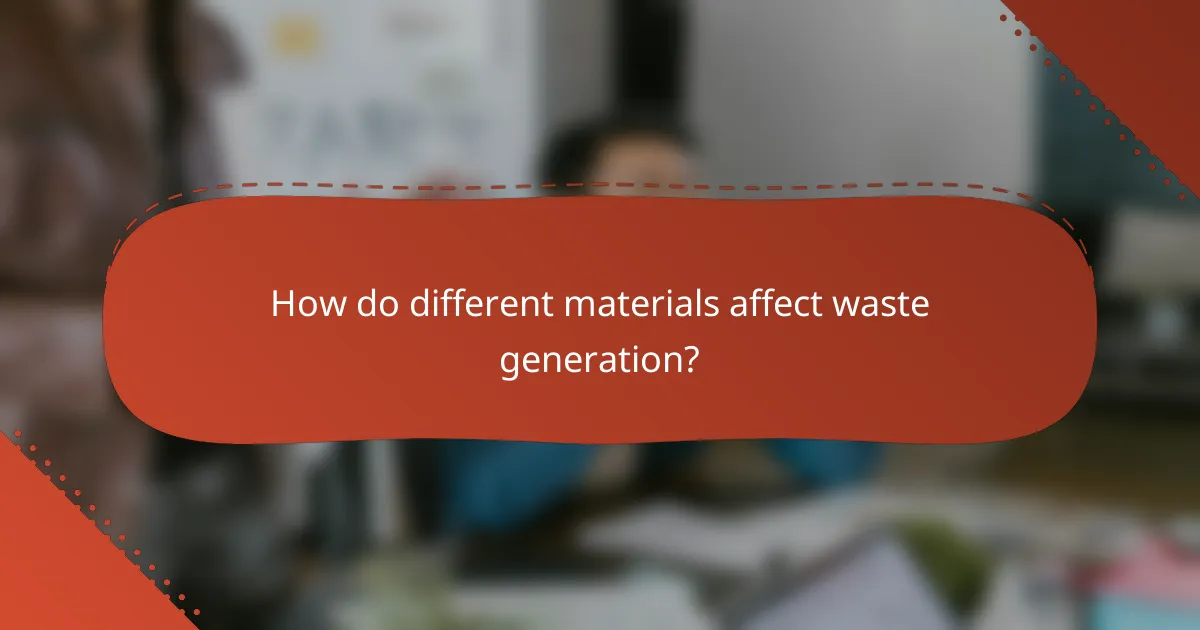Home renovation presents an opportunity to implement effective waste reduction strategies that conserve resources and lower costs. By meticulously planning projects, choosing modular designs, and utilizing digital design tools, homeowners can significantly minimize material waste. Embracing these sustainable practices not only benefits the environment but also enhances property value and overall efficiency during the renovation process.

What are effective waste reduction strategies for home renovation in urban areas?
Effective waste reduction strategies for home renovation in urban areas focus on minimizing material waste, maximizing recycling, and utilizing sustainable practices. Implementing these strategies not only conserves resources but also can lead to cost savings and a reduced environmental footprint.
Recycling construction materials
Recycling construction materials involves repurposing waste from renovation projects instead of sending it to landfills. Common materials that can be recycled include wood, metal, concrete, and drywall. Local recycling centers often accept these materials, and some cities have specific programs to facilitate construction waste recycling.
Before starting a renovation, check with local authorities to understand the recycling options available in your area. Consider setting up separate bins on-site for different materials to streamline the recycling process and ensure compliance with local regulations.
Using sustainable materials
Using sustainable materials in home renovations reduces environmental impact and promotes resource conservation. Look for materials that are renewable, recycled, or have low environmental footprints, such as bamboo flooring, reclaimed wood, or recycled metal roofing.
When selecting materials, consider their lifecycle impacts, including production, transportation, and disposal. Certifications like FSC (Forest Stewardship Council) for wood products can guide you in choosing environmentally friendly options.
Implementing a waste management plan
A waste management plan outlines how to handle waste generated during a renovation project. This plan should include strategies for reducing, reusing, and recycling materials, as well as disposal methods for non-recyclable items.
To create an effective plan, assess the types of materials you expect to generate, research local disposal regulations, and establish a timeline for waste removal. Regularly review and adjust the plan as needed to ensure it remains effective throughout the renovation process.
Donating usable items
Donating usable items from your renovation can significantly reduce waste while benefiting others. Many organizations, such as Habitat for Humanity ReStores, accept donations of furniture, appliances, and building materials that are still in good condition.
Before discarding items, evaluate their condition and check with local charities or nonprofits to see what they will accept. This not only helps the community but can also provide potential tax deductions for your donations.
Hiring eco-friendly contractors
Hiring eco-friendly contractors can enhance your renovation’s sustainability by ensuring that waste reduction strategies are effectively implemented. Look for contractors who prioritize green building practices and have experience with sustainable materials and waste management.
When interviewing potential contractors, ask about their waste reduction practices, recycling policies, and any certifications related to sustainable building. Choosing the right contractor can make a significant difference in the overall environmental impact of your renovation project.

How can homeowners minimize waste during renovations?
Homeowners can minimize waste during renovations by planning meticulously, opting for modular designs, and leveraging digital tools for design. These strategies not only reduce material waste but also enhance efficiency and cost-effectiveness throughout the renovation process.
Planning renovations carefully
Effective planning is crucial for minimizing waste during renovations. Start by assessing the existing space and determining what can be reused or repurposed, which can significantly cut down on material costs and disposal needs.
Create a detailed renovation plan that includes timelines, budgets, and specific materials required. This foresight helps avoid last-minute purchases that often lead to excess waste.
Consider consulting with a professional to ensure that your plans align with local building codes and regulations, which can help prevent costly mistakes and unnecessary waste.
Choosing modular designs
Modular designs are an effective way to minimize waste as they allow for easier assembly and disassembly. By using prefabricated components, homeowners can reduce the amount of material that ends up in landfills.
When selecting modular designs, look for options that can be easily adapted or expanded in the future. This flexibility can prevent the need for extensive renovations later, further reducing waste.
Examples of modular designs include kitchen cabinets, furniture, and even entire room additions that can be constructed off-site and assembled on location, minimizing on-site waste.
Utilizing digital tools for design
Digital design tools can significantly aid in waste reduction by allowing homeowners to visualize their projects before any physical work begins. Software programs can help create accurate measurements and layouts, reducing the likelihood of errors that lead to wasted materials.
Consider using 3D modeling software or apps that allow for virtual walkthroughs of your renovation plans. This can help identify potential issues early on, enabling adjustments to be made without the need for physical alterations.
Additionally, many digital tools can provide estimates for material quantities needed, helping to order only what is necessary and further minimizing excess waste.

What are the benefits of waste reduction in home renovation?
Waste reduction in home renovation offers significant advantages, including lower costs, a positive environmental impact, and enhanced property value. By minimizing waste, homeowners can save money, contribute to sustainability, and increase the appeal of their homes.
Cost savings
Reducing waste during renovations can lead to substantial cost savings. By reusing materials or opting for recycled options, homeowners can avoid the high costs associated with purchasing new supplies. For instance, salvaging fixtures or repurposing wood can cut expenses by a notable percentage.
Additionally, efficient project planning helps minimize excess materials, reducing disposal fees. Homeowners should consider donating usable items or selling them, which can further offset renovation costs.
Environmental impact
The environmental benefits of waste reduction in home renovation are significant. By diverting materials from landfills, homeowners contribute to lower greenhouse gas emissions and conserve natural resources. For example, recycling concrete and metal reduces the need for new extraction processes.
Moreover, choosing sustainable materials can enhance energy efficiency, leading to lower utility bills and a reduced carbon footprint. Homeowners should look for certifications like Energy Star or LEED when selecting materials to ensure they are making environmentally friendly choices.
Increased property value
Implementing waste reduction strategies can increase a home’s market value. Eco-friendly renovations often appeal to buyers who prioritize sustainability, making the property more attractive. Features like energy-efficient appliances or reclaimed wood flooring can set a home apart in a competitive market.
Furthermore, homes that demonstrate a commitment to sustainability may qualify for green certifications, which can enhance their marketability. Homeowners should keep records of sustainable practices and materials used, as these can be valuable selling points during a property sale.

What are the prerequisites for effective waste management in renovations?
Effective waste management in renovations requires a clear understanding of local regulations and an assessment of current waste disposal options. By knowing the rules and available services, homeowners can minimize waste and ensure compliance during their renovation projects.
Understanding local regulations
Familiarizing yourself with local regulations is crucial for effective waste management. Many municipalities have specific laws regarding construction waste disposal, recycling mandates, and landfill restrictions. Check with your local government or waste management authority to understand these requirements.
For example, some areas may require permits for large-scale renovations, while others might have designated recycling facilities for materials like wood, metal, and concrete. Ignoring these regulations can lead to fines or project delays.
Assessing current waste disposal options
Evaluating your current waste disposal options is essential for minimizing renovation waste. Start by identifying local waste management services that cater to construction debris. Many companies offer specialized bins for different types of materials, which can help streamline the disposal process.
Consider the cost-effectiveness of various disposal methods, such as renting a dumpster versus using curbside pickup. Additionally, explore recycling programs that may provide incentives for reducing landfill contributions. By choosing the right disposal options, you can significantly reduce your renovation’s environmental impact.

How do different materials affect waste generation?
Different materials significantly influence waste generation during home renovation projects. Sustainable materials typically produce less waste and have a lower environmental impact compared to traditional options, which often contribute to higher levels of waste and pollution.
Comparing traditional vs. sustainable materials
Traditional materials, such as concrete and vinyl, often lead to substantial waste due to their manufacturing processes and disposal challenges. In contrast, sustainable materials like bamboo, reclaimed wood, and recycled metal are designed to minimize waste and can often be repurposed or recycled more easily.
When choosing materials, consider the waste generated not only during installation but also at the end of their lifecycle. Sustainable options may have a higher upfront cost but can lead to long-term savings by reducing waste disposal fees and environmental impact.
Evaluating the lifecycle of materials
The lifecycle of materials includes extraction, manufacturing, transportation, use, and disposal. Each stage can contribute to waste generation, with some materials producing more waste than others. For instance, materials with a high recycled content often have a lower overall waste footprint.
To evaluate materials effectively, consider their durability and potential for reuse. For example, high-quality materials may last longer, reducing the need for replacements and minimizing waste over time. Additionally, local regulations may encourage the use of materials that meet specific sustainability standards, further influencing your choices.

What are common mistakes to avoid in waste reduction?
Common mistakes in waste reduction during home renovation include underestimating waste volume, neglecting recycling opportunities, and ignoring local disposal guidelines. Avoiding these pitfalls can significantly enhance your waste management efforts and minimize environmental impact.
Underestimating waste volume
Many homeowners fail to accurately estimate the amount of waste their renovation will generate. This can lead to insufficient planning for disposal and recycling options. A good rule of thumb is to expect that renovation projects can produce waste that is 10-20% of the total project cost.
To avoid this mistake, conduct a thorough assessment of the materials being removed and replaced. Consider using a waste calculator or consulting with a contractor to get a more accurate estimate of the expected waste volume.
Neglecting to recycle
Failing to recycle materials is a common oversight that can greatly increase landfill contributions. Many renovation materials, such as wood, metal, and certain plastics, can be recycled or repurposed. Research local recycling facilities to understand what materials they accept.
Implement a sorting system on-site to separate recyclable materials from general waste. This not only reduces landfill waste but can also save on disposal costs, as some recycling centers may offer financial incentives for large quantities of materials.
Ignoring local disposal guidelines
Each locality has specific regulations regarding waste disposal that must be followed. Ignoring these guidelines can lead to fines and complications during the renovation process. Familiarize yourself with your local waste management policies to ensure compliance.
Check with your local government or waste management authority for detailed information on disposal methods, including hazardous waste handling and designated drop-off locations. Adhering to these guidelines not only helps the environment but also keeps your project on track and within legal boundaries.
